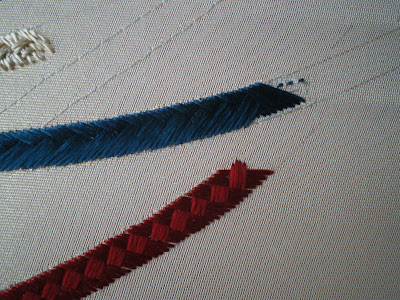
© JEC/Carol-Anne Conway
So what to do now? My big problem was that despite my reservations I had gone ahead and done the finishing, including gluing the back with wheat starch. For fear of getting paste on the fabric, I applied a very thin layer along the lines of the tassel. None the less, I was concerned that if I attempted to remove the stitching it would damage the fabric. Fortunately, Susan provided me with idea that might 'beef' up my tassels without reverse stitching what I had already one. For Phase V, Susan stitched the Kumihomi Cord clutch bag. The tassel on the back of the bag is almost identical to the tassel on Himotaba. The two major differences are that the Kumihomi Cord tassel has twice as many strands as Himotaba one and the tips of the pink tassel change to gold. I really like the gold tips but really did not want to risk removing any of the pasted stitching, however, I did think that I could stitch an additional line of staggered diagonals between the existing lines. I spent from Sunday to Friday debating with myself whether or not to do this.
On Friday morning, I decided I should do it. An hour later I had stitched 3 lines between the existing lines and there was no going back. Which of course is the ideal time for the internal critic to chime in and tell me that I had made a BIG mistake.

© JEC/Carol-Anne Conway
Another 24 hours later, I decided that there was no going back, so I had to live with my decision and finishing stitching between all of the lines.

© JEC/Carol-Anne Conway
The more I stitched, the more confident I became that I had made the right decision and when I finished I was much more satisfied with the tassel.
After seeing Susan's tassel with it's gold tips, I was very tempted to stitch mine in a similar way but still I did not want the tassel to completely dominate the design. I hope that the version I have settled on provides the right balance of a tassel befitting a double central cord but one that does not detracted from the other cords.
Happy Stitching

















